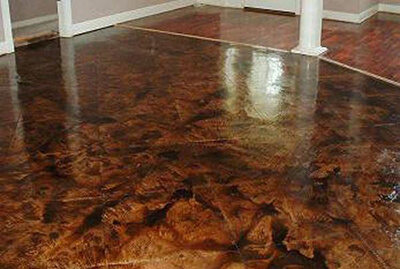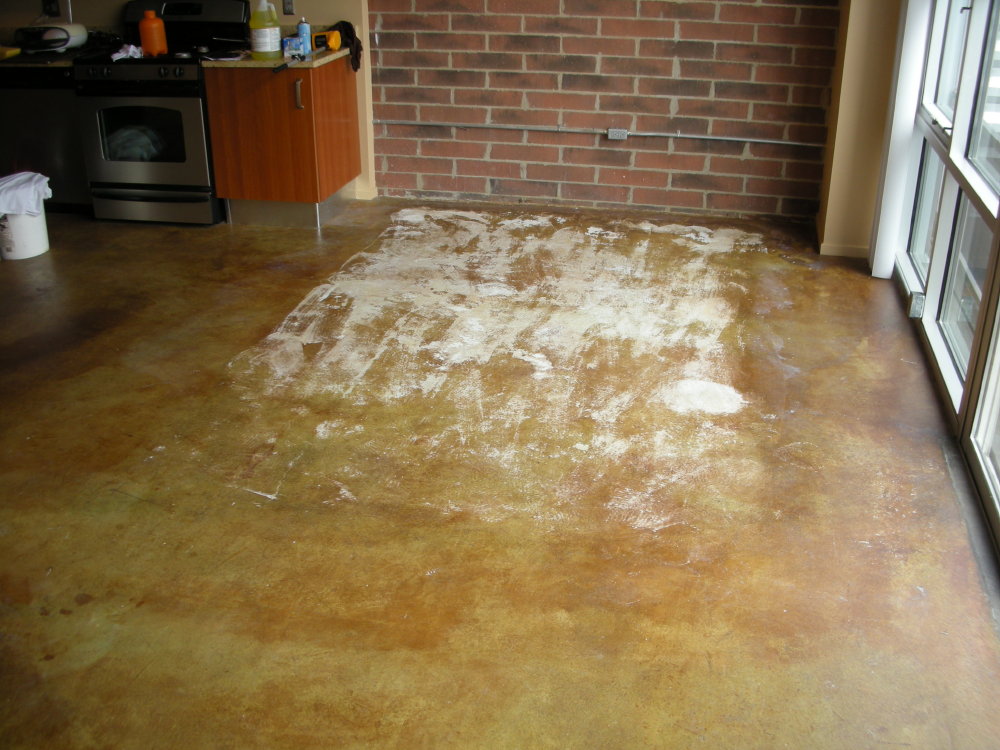Why skilled stained concrete contractors deliver better quality
Everything About Stained Concrete: A Comprehensive Guide to Its Advantages and Applications
Stained concrete has actually arised as a prominent choice for both property and industrial spaces. Its ability to combine aesthetic charm with functionality makes it an appealing option. Different discoloration methods offer a series of colors and surfaces, permitting modification. However, the advantages expand beyond look. Comprehending its applications and maintenance requirements is vital for any individual considering this versatile product. The nuances of stained concrete invite further expedition.
What Is Stained Concrete?

Staining can be related to different surfaces, consisting of floors, driveways, and patio areas, making it a versatile alternative for both interior and outside rooms. The therapy can attain a variety of appearances, from earthy tones to strong, modern-day designs. Unlike paint, stained concrete maintains its look gradually, as it ends up being an essential component of the concrete itself. Generally, stained concrete functions as an efficient method for changing ordinary concrete into visually striking surfaces.
Benefits of Stained Concrete
Stained concrete offers substantial benefits, especially in visual allure and longevity - stained concrete. Its dynamic shades and one-of-a-kind patterns improve the visual charm of any area, making it a prominent choice for both residential and commercial applications. In addition, the longevity of stained concrete guarantees that it stays a practical investment in time, withstanding damage
Visual Appeal
One of one of the most compelling benefits of using stained concrete is its amazing aesthetic charm. Stained concrete offers a distinct and flexible look that can complement numerous design styles, from contemporary to rustic. The mixture of vibrant colors and intricate patterns allows home owners and designers to produce tailored surface areas that can enhance the total ambiance of a room. Unlike traditional floor covering alternatives, stained concrete can simulate the appearance of natural rock or polished marble, providing an upscale appearance without the connected costs. In addition, the shiny finish options can mirror light, more brightening insides. This flexibility makes stained concrete a preferred option for both household and business applications, where visual effect is critical.
Toughness and Longevity
The remarkable visual top qualities of stained concrete are matched by its remarkable resilience and long life - stained concrete. Stained concrete surface areas are immune to damage, making them ideal for high-traffic locations both indoors and outdoors. Their durable nature implies they can stand up to severe weather, consisting of severe temperatures, rain, and UV exposure, without substantial deterioration. In enhancement, stained concrete needs very little upkeep compared to various other floor covering options, as it does not need frequent securing or refinishing. This long life not just minimizes substitute prices however likewise adds to a lasting structure approach. Generally, stained concrete supplies an enduring solution that incorporates visual appeal with sensible benefits, ensuring its value with time
Different Sorts Of Staining Methods
Various discoloration techniques can considerably affect the aesthetic high qualities of concrete surfaces. The three key techniques consist of acid discoloration, which reacts chemically with the concrete, water-based discoloration, which offers a broader series of colors, and overlay staining options that offer a fresh surface. Each method has one-of-a-kind features and applications that cater to different style choices and project needs.
Acid Staining Method
How can property owners transform ordinary concrete surfaces into aesthetically striking features? One efficient approach is acid staining, a popular technique that improves the natural appeal of concrete. This procedure entails applying a solution of water, hydrochloric acid, and metallic salts to the concrete surface area. As the acid reacts with the lime present in the concrete, it creates rich, variegated shades that appear like marble or rock. Acid staining is understood for its durability and resistance to fading, making it a resilient selection for both interior and outside applications. Nonetheless, it is important to keep in mind that the outcomes can differ based on the initial concrete color and structure - stained concrete company. Proper application and sealing are essential for accomplishing the preferred aesthetic and long life
Water-Based Staining Method
A prominent alternative to acid discoloration, the water-based staining strategy offers house owners her comment is here a versatile method to enhance concrete surface areas. This method utilizes water-soluble dyes and pigments, permitting a variety of shades and surfaces. Unlike acid discolorations, water-based discolorations can be put on unsealed concrete and use a simpler cleaning process. The results can attain a much more consistent appearance and can be layered to produce distinct results. Additionally, water-based discolorations are typically much less hazardous and send out less volatile organic compounds (VOCs), making them extra eco-friendly. Homeowners might appreciate the capacity to tailor their concrete surface areas with numerous tones, permitting innovative expression while maintaining longevity and durability in their flooring choices.
Overlay Discoloration Options
Numerous overlay discoloration choices exist for homeowners aiming to invigorate their concrete surface areas. One preferred selection is acid staining, which reacts chemically with the concrete to produce rich, variegated shades. Another choice is water-based staining, offering a more comprehensive color palette and less complicated application. Additionally, concrete overlays can be integrated with patterns for detailed styles, improving aesthetic appeals. For a much more textured finish, home owners might consider making use of stamped overlays that resemble natural materials like rock or floor tile. Each technique offers special advantages, from resilience to personalization, enabling a customized touch. Eventually, the selection of overlay staining depends upon the desired appearance and the condition of the existing concrete, ensuring a refreshed and appealing surface area.
Applications of Stained Concrete
Stained concrete deals a flexible option for different applications, boosting both visual appeal and performance. This material is frequently used in property, business, and industrial settings, making it a preferred choice among designers and designers. In homes, stained concrete can work as stylish floor covering or exterior patios, providing an innovative look while remaining sturdy.
In business areas, such as stores and dining establishments, stained concrete adds to a modern atmosphere and can stand up to heavy foot web traffic. Additionally, stained concrete is progressively utilized in public rooms like parks and continue reading this walkways, where its ability to simulate all-natural rock or various other products adds aesthetic passion.
Stained concrete is optimal for pool decks and driveways, using a slip-resistant surface that is simple to maintain. Overall, the versatility of stained concrete makes it appropriate for various atmospheres, satisfying diverse preferences and needs.
Maintenance and Look After Stained Concrete
Appropriate upkeep guarantees the longevity and beauty of stained concrete surfaces. Normal cleaning is crucial; using a moderate cleaning agent and water with a soft-bristle brush aids eliminate dirt and gunk without damaging the coating. It is recommended to stay clear of rough chemicals that can strip away the tarnish or sealant.
Sealing stained concrete is crucial for protection versus moisture, stains, and use. A high-grade sealer should be reapplied every one to three years, depending on the traffic and exposure the surface endures. Additionally, dealing with spills without delay will prevent staining and discoloration.

Expense Factors To Consider for Stained Concrete Projects
When planning a stained concrete project, budget factors to consider play a necessary function in figuring out the overall expense. The costs related to stained concrete can vary considerably based on a number of aspects. Initially, the size of the area to be stained straight affects material and labor prices. Larger rooms will normally require more resources. Second, the kind of stain selected-- acid-based or water-based-- can influence prices, with acid spots frequently being much more pricey. In addition, the complexity of the layout, including patterns or several colors, can raise labor costs. Preparation work, such as cleaning and grinding the concrete surface area, contributes to the first expenses too. The selection between DIY setup and working with an expert service provider will additionally influence the spending plan. Understanding these variables allows homeowners to make informed economic decisions regarding their stained concrete tasks, ensuring they achieve the desired aesthetic within their financial methods.
Tips for Selecting the Right Stained Concrete for Your Area
Selecting the appropriate stained concrete for a particular room entails cautious reflection of different factors past just spending plan. One must assess the desired use of the area. High-traffic areas may need even more resilient coatings, while ornamental applications can prioritize appearances.
The color palette is another essential facet; the chosen shades ought to balance with existing design and lighting. It's additionally essential to take right into account the surface area structure, as smooth surfaces can improve class, while distinctive alternatives might ensure safety in damp areas.
Local environment and environmental problems play a considerable role in the long life and maintenance of stained concrete, affecting the option of sealants and coatings.
Lastly, seeking advice from specialists can provide beneficial insights tailored to specific requirements, ensuring the selection of the ideal stained concrete that aligns with both capability and design.
Often Asked Inquiries
Can Stained Concrete Be Applied Over Existing Flooring?
Stained concrete can without a doubt be used over existing flooring, supplied the surface area is secure and adequately prepared. This approach permits for an aesthetic upgrade without the requirement for total removal of the initial flooring products.
How Much Time Does Stained Concrete Last?
Stained concrete can last for years my response when effectively maintained. Factors such as traffic, ecological problems, and application techniques considerably affect its long life, with many installations continuing to be dynamic and undamaged for 10 to 30 years.
Is Stained Concrete Slippery When Damp?
Stained concrete can be slippery when damp, as the finish may produce a smooth surface. However, making use of non-slip ingredients or distinctive surfaces can minimize this concern, enhancing safety without endangering the visual allure of the concrete.
Can I Discolor Concrete Myself, or Should I Hire a Professional?
The decision to stain concrete personally or employ a specialist joints on skill level and job intricacy. While DIY discoloration can save money, experts guarantee suitable results, particularly for elaborate designs or large surface areas.
What Color styles Are Offered for Stained Concrete?
The variety of colors readily available for stained concrete consists of earthy tones like browns and tans, dynamic tones such as reds and blues, and softer tones like pastels. This combination permits imaginative, tailored layout options.